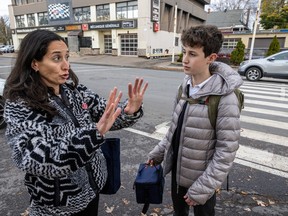“I take care of children who are trauma victims,” Dr. Samara Zavalkoff said. “I don’t need a good imagination to know what we avoided.”

Charlie Shein, a 14-year-old Secondary 3 student at Royal West Academy in Montreal West, was struck by a car on Westminster Ave. on his way to school one recent morning, on a crosswalk in an area residents have long been flagging as dangerous.
He was lucky — he sustained only scrapes and bruises. His mother, a physician in the pediatric intensive-care unit at the Montreal Children’s Hospital, knows things could have been far worse.
“I take care of children who are trauma victims,” Dr. Samara Zavalkoff said. “I don’t need a good imagination to know what we avoided.”
She knows her son could have been killed — or sustained a traumatic brain injury, landed in intensive care and needed months of rehabilitation.
“The universal reaction to this event was: ‘No surprise,’ ‘It’s so dangerous,’ ‘It was bound to happen,’” she said in an email to other Royal West parents.
In addition to being an ICU physician and associate professor at McGill University, Zavalkoff is associate director of the pediatric intensive-care unit at the Children’s and the hospital’s medical director of quality and safety. “Given these roles and given that I am a mother, I felt I cannot just be grateful and wait for the next event.
“We won’t be so lucky next time.”
There is a steady stream of traffic in both directions along southern Westminster as drivers turn south from Sherbrooke St. or commuters use the artery as an exit point to highways east and west. In the morning, there are parents dropping their kids off at school. The area can be congested and drivers get impatient. There’s a railway crossing at Westminster a block or so north of the school, and in the morning students pour from the commuter trains at the Montreal West train station: Royal West, a prestigious English Montreal School Board high school, draws students from as far afield as Châteauguay and Brossard.
There are two crosswalks on Westminster near Ainslie Rd. a few hundred metres east of the school and students are told to use the one to the south; it has striped yellow lines. There are stop signs, but there is no crossing guard. The Montreal police department, which has responsibility for school crossing guards, says they are available only at elementary schools except when a high school is nearby and they use the same crossing.
The morning of Oct. 28, Shein, who takes the train from Vendôme, walked south from the station along the east side of Westminster to the southern crosswalk. He started to cross. A car was heading south slowly and he thought it would stop. He was hit on his right side and knocked to the pavement on his left. The morning sun was bright and the driver, who may have been blinded by the glare, stopped immediately. One or more 911 calls were made and Shein was taken by ambulance to the Montreal Children’s emergency, where his parents waited.
Debbie Friedman, trauma director at the Montreal Children’s, director of the Canadian Hospitals Injury Reporting and Prevention Program (CHIRPP) and an associate professor at McGill, echoed Zavalkoff’s concerns. “Everybody is impacted when something like this happens. Why do we have to wait until someone ends up with a serious brain injury and bone fractures before we realize this is a situation that needs to be remedied?”
What happened to Shein was “entirely preventable,” she said. “Here you have a situation with a high volume of activity and not the best way for people to get across the street safely. We don’t need to see 50 cases to know there is a problem. We should take advantage of the situation to put our heads together and try to find a solution.”
The solution may be a crossing guard, or additional stop signs, or illuminated signs over a crossing known to be dangerous. The goal is to “find a road safety measure to ensure everyone’s safety,” Friedman said.
Based on the past three years of data reported to CHIRPP by the Montreal Children’s Hospital trauma centre, an average of 10 pedestrians and cyclists age six to 11 in and around Montreal (mostly pedestrians) are hit each year by a moving vehicle between 7 a.m. and 6 p.m. on school days. For students age 12 to 17, the average is 20.
An increased police presence on Westminster was noticed in the days following the Oct. 28 incident. Zavalkoff has filed an official complaint with Station 9, the police station on Westminster Ave., to lobby for additional resources, including someone at the crosswalk. Montreal police said on Wednesday that officers from Station 9 who are responsible for road safety will lead an awareness-raising campaign “in the coming days” at the Westminster-Ainslie intersection.
Zavalkoff reached out by email to Lauren Small Pennefather, the Montreal West councillor responsible for public security, who responded that the safety concerns she is raising are “top of mind for all of council” and outlined several actions council has taken to address safety issues on Westminster.
She advised, rather, that the issue be brought up at the next meeting of the school’s governing board, that it request an urgent meeting with the Montreal West mayor, and that parents attend council meetings and continue to raise the issue. The governing board meets next on Nov. 19, and Montreal West council on Nov. 25.
“You have to work with the municipality to make roads safer,” Korakakis said. “You go to council, you talk about it and work to find solutions. You don’t wait for a kid to die.”